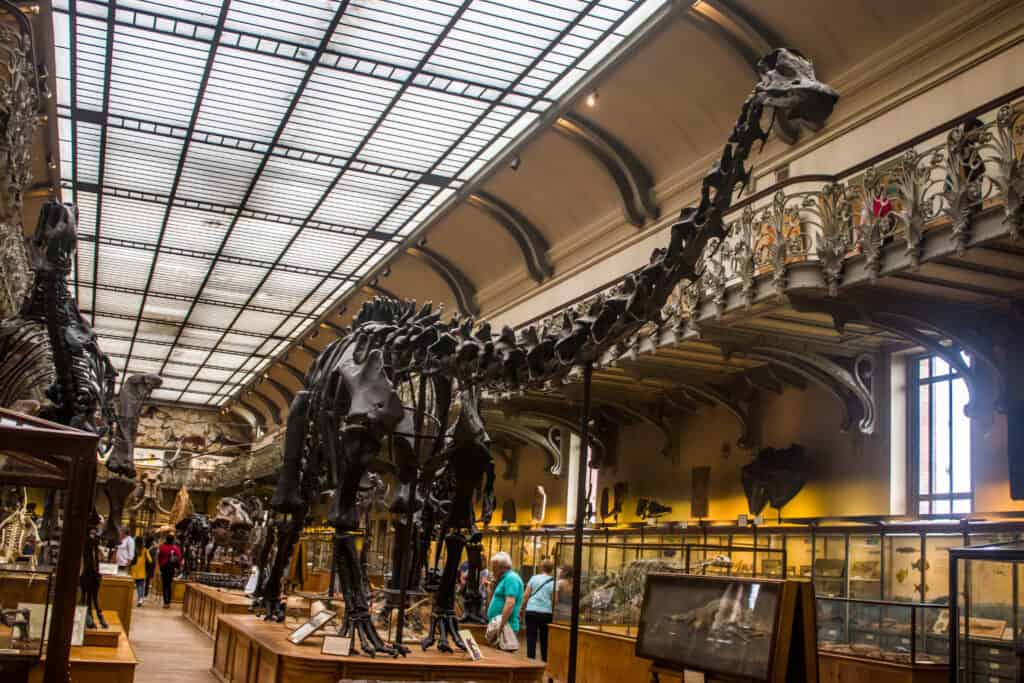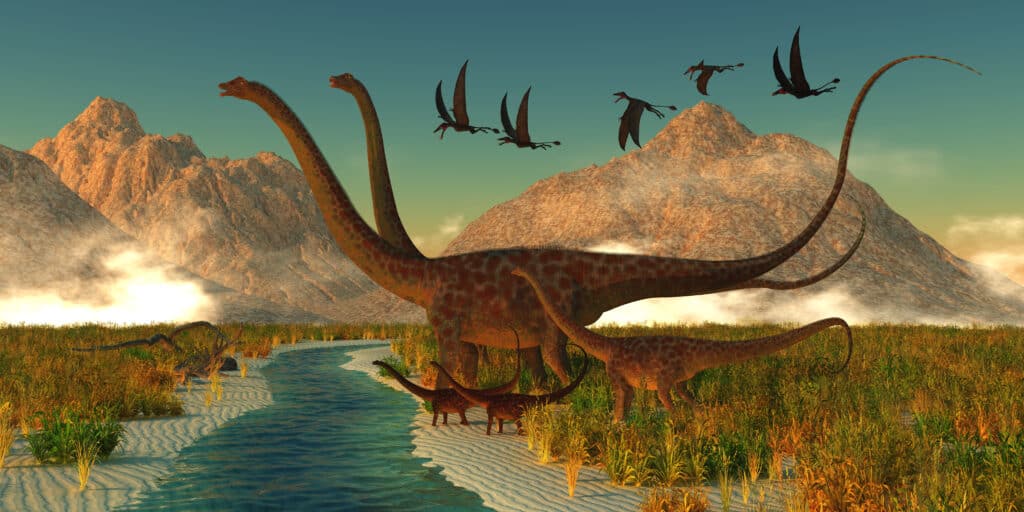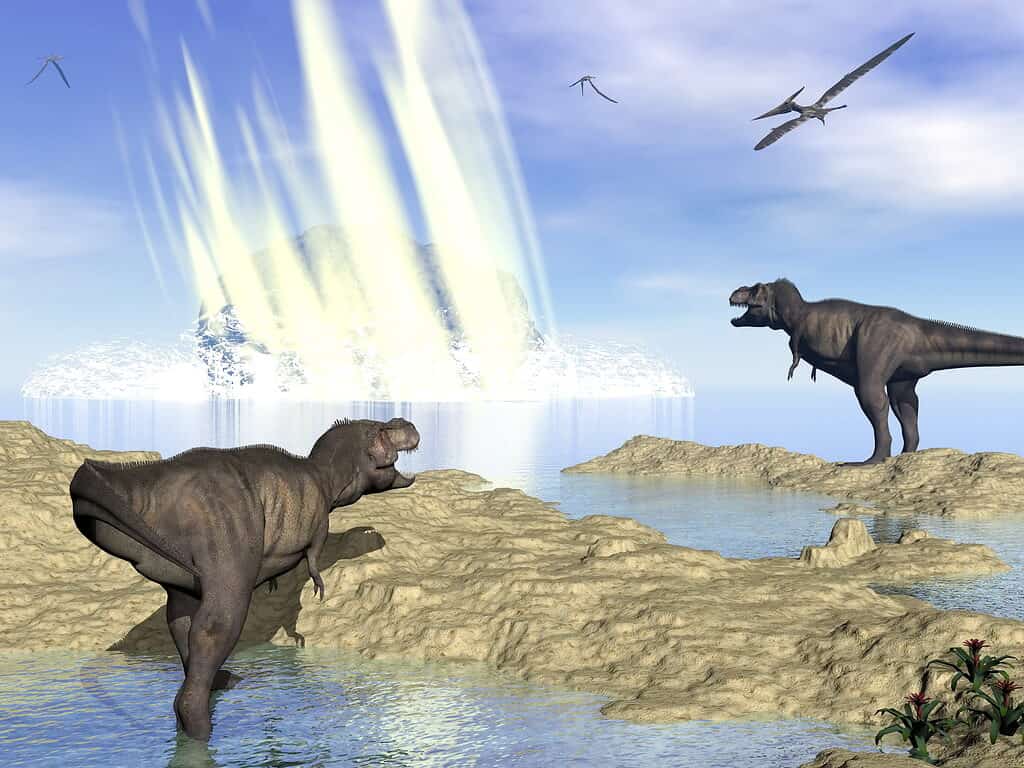The blue whale is the largest extant creature, meaning it is the largest animal alive today. However, several dinosaurs in the past equaled or exceeded the total length of this mammal. One blue whale-sized dinosaur was considered one of the largest animals ever, and it did not have the benefit of the support of water. Take a look at this massive dinosaur and learn when it lived, how large it grew, and why it went extinct!
What Was the Blue Whale-Sized Dinosaur?

Diplodocus was a massive, tall dinosaur that lived in North America.
©Danny Ye/Shutterstock.com
Diplodocus was the blue whale-sized dinosaur that once walked the earth. Members of this genus were very large. Diplodocus longus, the type species, is estimated to have grown about 92 feet long and weighed about 15 tons or 30,000 pounds. Like other sauropods, Diplodocus was known for its very long tail, stout body, pillar-like legs, very long neck, and a surprisingly small head.
However, other members of this species were a fair bit larger. For example, Diplodocus hallorum may have reached lengths of 110 to 120 feet. This creature, also called Seismosaurus, is more in line with the length of a blue whale. However, its body mass does not match that of the great creature of the ocean.
After all, Diplodocus hallorum only weighed about 25 tons or 50,000 pounds. Compared to a blue whale, it was very light. A blue whale can range in size from 90 to 110 feet while weighing between 100,000 and 330,000 pounds!
The latter weight would be very hard to sustain on land. That’s especially true when considering that these were herbivorous dinosaurs. They would have had to eat a great deal of vegetation to meet their energy needs. Overall, Diplodocus was a very large animal that is somewhat analogous in size to a blue whale, except it hefted its enormous weight across the land.
When Did Diplodocus Live?

once lived in the area that is now Colorado, Utah, Montana, and Wyoming.
©Catmando/Shutterstock.com
Diplodocus lived between 161.2 and 145 million years ago. Many other large dinosaurs appeared during this time including the biggest sauropods. Diplodocus’ sizeable contemporaries included Brontosaurus, Apatosaurus, and Supersaurus.
The blue whale-sized dinosaur lived in a period called the Late Jurassic. However, Diplodocus and many other dinosaurs went extinct by the end of this era.
Fortunately, scientists have recovered fossil remains that provide some insight into these reptiles. The Late Jurassic is the time when Pangaea broke up into Gondwana and Laurasia, two supercontinents. The remains of Diplodocus have been found in several places. Most famously, some fossils were found in Colorado, a state known for its rich paleontological and geological finds.
The first fossil recovery occurred in Garden Park, Colorado. Subsequent finds occurred during the Bone Wars, a period of fossil hunting that was partially motivated by a rivalry between Othniel Marsh and Edward Drinker Cope, two paleontologists.
Other important finds came from the Morrison Formation in Wyoming, Montana, and Utah. While these dinosaurs certainly lived in the area that would become North America, it is not known if they lived in other places as well. Humans have found evidence of very large dinosaurs throughout the Americas, like Argentinosaurus in South America.
Was Diplodocus the Largest Dinosaur Ever?

Supersaurus was larger than Diplodocus, and it was the biggest dinosaur ever!
©HugYou/Shutterstock.com
Given that Diplodocus is a blue whale-sized dinosaur and the blue whale is the largest creature alive on the planet today, it’s easy to think that it may have been the largest dinosaur ever. However, they were not.
In fact, Diplodocus does not even crack the top five largest dinosaurs ever! So, what was the largest? Well, that is a matter of debate among scientists. Ongoing dinosaur fossil discoveries change the narrative every few years as lengths, heights, and weights are revised and presented for peer review.
As of 2021, the largest dinosaur to exist is Supersaurus. This “super lizard” measured between 105 and 138 feet long and weighed about 70,000 pounds to 80,000 pounds. The creature may have grown as tall as 50 feet counting the height of its head and neck help aloft. Future fossil finds and reassessments could change the order of the largest dinosaurs, though.
When Did the Blue Whale-Sized Dinosaur Go Extinct and Why?

An asteroid, like the one that hit Earth 66 million years ago, may have helped wipe out dinosaurs in the Late Jurassic Period.
©Elenarts/Shutterstock.com
Diplodocus, along with many other Late Jurassic dinosaurs, went extinct about 145 million years ago. However, scientists do not know exactly why the dinosaurs were wiped out. Unlike the Cretaceous-Paleogene Extinction, no evidence of a massive calamity has been found around this time.
Nevertheless, this blue whale-sized dinosaur and many other massive sauropods disappeared around the same time. Given their immense size, it’s not likely that they were hunted to extinction. Even deadly carnivorous dinosaurs like Allosaurus would not have posed much of a threat to a fully grown Diplodocus.
An impact from an asteroid or meteorite could have accelerated the genus’ decline, or an increase in volcanic activity could have harmed the population. Scientists need a great deal more information before they can confirm the cause of this creature’s extinction.
Can You See Fossils of Diplodocus?

You can see a recreation of
Diplodocusin a few museums.
©Basilio Dovgun/Shutterstock.com
Seeing the actual fossils of this dinosaur genus is difficult due to the lack of specimens. However, you can see casts and recreations of the fossils of Diplodocus carnegii in the Carnegie Museum of Natural History. The museum contains a wealth of information about this dinosaur including maps, diagrams, and written correspondence about the dig site in which the dinosaur was discovered.
Fragments of Diplodocus along with a recreation of the dinosaur may also be found at the Denver Museum of Nature & Science! The recreations of these dinosaurs show just how large the creatures stood in real life.
While Diplodocus was about as long as a blue whale, it can not match the whale’s weight. Still, it’s interesting to think that the largest animals alive today are roughly the length of animals that once walked the earth!
The photo featured at the top of this post is © Elenarts/Shutterstock.com
Thank you for reading! Have some feedback for us? Contact the AZ Animals editorial team.







